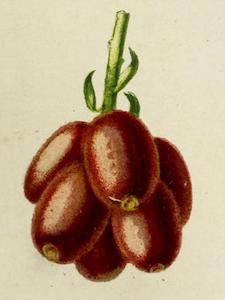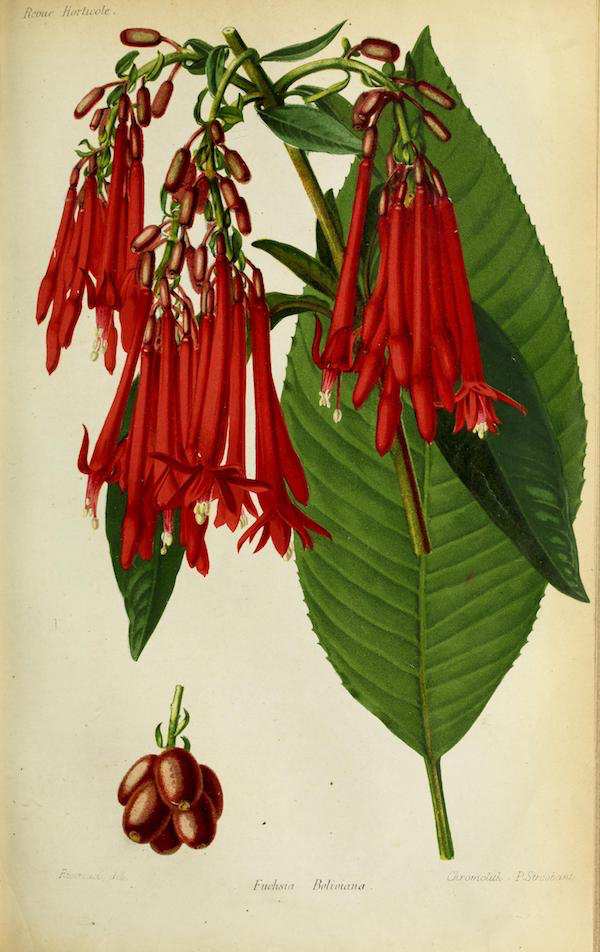Fuchsia boliviana. Good for what ails the heart
Tuesday, February 14, 2017

First off, make sure it’s actually ripe. Yes, please. It helps. The berries’ taste really is uneven, though. This fact is again not surprising. Fuchsias are bred for the interest of their flowers rather than taste.
Last year, Thompson & Morgan’s introduced ➤ Fuchsia ‘Fuchsiaberry’. This is a long-awaited step in the right direction and they get a Fuchsia Medal for going where others haven’t. Especial thanks to Michael Perry, ➤ Mr. Plant Geek himself. He’s struck off from T&M on his own but still gets an honorary medal for his instrumental role in eating your fuchsias. Lots of breeding can still to be done to make fuchsia fruit even better. Guys, keep on crossing!
In the meantime, some of the best tasting berries are found on a number of species. Fuchsia excorticata, for example, is the native tree fuchsia of New Zealand. Its fruit was relished by the Maori who called the tree kotukutuku and the berries konini.
The Maori saying, "I whea koe I te tahuritanga o te rau o te kotukutuku?", or "Where were you when the leaves of the fuchsia tree began to grow in the spring?", is a reproach against those who show up at harvest time but are nowhere to be found when work needs to be done at planting time.
Similar is Fuchsia boliviana. Discovered and described by botanists only in the 1870s, it was originally native to moist thickets in cloud forest at elevations from six hundred and a thousand meters to three thousand meters in Southern Peru, Bolivia and Northwestern Argentina. But the botanists were late to the party. The berries of Fuchsia boliviana had already been enjoyed by the native peoples of the Andes for centuries.
The plant was spread from its original home long ago. No one remembers how long ago. It made its way up the Andes and is now widely naturalized in Columbia and Venezuela, and even into Central America and Southern Mexico.
Today it can be found growing merrily in friendly climates from the Caribbean to India. From Madiera to Sri Lanka, And beyond. This is likely because it stays in flower much of the year, self pollinates, reproduces by shoots, and tolerates much drier and harsher conditions than many other members of this fine genus. Oddly, it’s mostly still seen as an ornamental to decorate the garden. Like most fuchsias, it’ll grow perfectly fine in a pot as well.
In Quechua, the Inca language, Fuchsia boliviana is called chimpu-chimpu and the clusters of its flowers once had royal associations with the Inca ruler and the Sun God. I’ll get back to those in another blog. In Spanish, it’s come to be called corazón-corazón, or “heart-heart”. And for a reason. They’re considered not only tasty but good for what ails the heart. You can even buy them over the counter in local markets.
A little depressed? Feeling blue that those Valentine’s cards aren’t rolling in? Not to fear. Follow some good old Andean advice and put some corazón-corazón on your morning quinoa to kick start the day.
On the side of a cold, wet Andean blanket, though, there’s no real scientific evidence for this particular belief. None. But, hey, it is the land that gave the world the potato after all. And Fuchsia boliviana berries do taste good so eat to your heart’s content. That’s enough to lift flagging spirits and maybe that’s what’s really meant by being good for the heart.

(Illustrations: Fuchsia boliviana Carrière, Revue Horticole, Series 4, Vol. 48, 1876.)